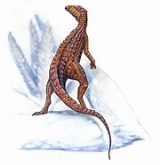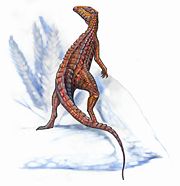
Scutellosaurus
Encyclopedia
Scutellosaurus is a genus
of herbivorous
dinosaur
that lived in North America
around 200 to 196 million years ago, in the Early Jurassic
times.
It is classified in Thyreophora
, the armoured dinosaurs; its closest relatives may have been Emausaurus
and Scelidosaurus
, another armored dinosaur which was mainly a quadrupedal dinosaur, unlike bipedal Scutellosaurus. It is one of the earliest representatives of the armored dinosaurs and the basalmost form to date.

, although of the skull only the lower jaw has been recovered. There were also several hundred scute
s running along its neck to its back and as far down as its tail. Some of these shields were flat, while others were pitted. It had an unusually long tail, possibly to provide a counterbalance against the weight of the armored body, and long arms that suggest it may have browsed on all fours.
Genus
In biology, a genus is a low-level taxonomic rank used in the biological classification of living and fossil organisms, which is an example of definition by genus and differentia...
of herbivorous
Herbivore
Herbivores are organisms that are anatomically and physiologically adapted to eat plant-based foods. Herbivory is a form of consumption in which an organism principally eats autotrophs such as plants, algae and photosynthesizing bacteria. More generally, organisms that feed on autotrophs in...
dinosaur
Dinosaur
Dinosaurs are a diverse group of animals of the clade and superorder Dinosauria. They were the dominant terrestrial vertebrates for over 160 million years, from the late Triassic period until the end of the Cretaceous , when the Cretaceous–Paleogene extinction event led to the extinction of...
that lived in North America
North America
North America is a continent wholly within the Northern Hemisphere and almost wholly within the Western Hemisphere. It is also considered a northern subcontinent of the Americas...
around 200 to 196 million years ago, in the Early Jurassic
Jurassic
The Jurassic is a geologic period and system that extends from about Mya to Mya, that is, from the end of the Triassic to the beginning of the Cretaceous. The Jurassic constitutes the middle period of the Mesozoic era, also known as the age of reptiles. The start of the period is marked by...
times.
It is classified in Thyreophora
Thyreophora
The Thyreophora were a subgroup of the ornithischian dinosaurs...
, the armoured dinosaurs; its closest relatives may have been Emausaurus
Emausaurus
Emausaurus is a genus of thyreophoran or armored dinosaur from the Early Jurassic. Its fossils have been found in Germany. It is known from a skull and partial postcranial remains, although only the skull is known well. Armor includes conical scutes and tall, spiny elements.The type species,...
and Scelidosaurus
Scelidosaurus
Scelidosaurus is a genus of quadrupedal, lightly plated, herbivorous dinosaur about long. It lived during the Early Jurassic Period, during the Hettangian to Sinemurian stages around 199.6 to 194 million years ago. Its fossils have been found in both England and in Arizona, in the United...
, another armored dinosaur which was mainly a quadrupedal dinosaur, unlike bipedal Scutellosaurus. It is one of the earliest representatives of the armored dinosaurs and the basalmost form to date.

Description
Scutellosaurus was around 1.2 metres (3.9 ft) long, 50 centimetres (19.7 in) tall at the hips, and weighed 10 kilograms (22 lb). The fossil evidence includes two partial skeletons recovered from ArizonaArizona
Arizona ; is a state located in the southwestern region of the United States. It is also part of the western United States and the mountain west. The capital and largest city is Phoenix...
, although of the skull only the lower jaw has been recovered. There were also several hundred scute
Scute
A scute or scutum is a bony external plate or scale, as on the shell of a turtle, the skin of crocodilians, the feet of some birds or the anterior portion of the mesonotum in insects.-Properties:...
s running along its neck to its back and as far down as its tail. Some of these shields were flat, while others were pitted. It had an unusually long tail, possibly to provide a counterbalance against the weight of the armored body, and long arms that suggest it may have browsed on all fours.

